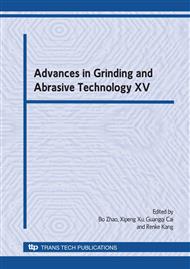p.426
p.432
p.439
p.443
p.449
p.455
p.461
p.467
p.472
Research on the Performance of the Copper Based Diamond Saw
Abstract:
The copper based diamond saw was manufactured by the hot-pressure sintering. The WC and Cr were added in the bond. The effects of the sintering parameters and the components on the performance of the saw were investigated. The integration status between the bond and the diamond was discussed. It’s shown that the hardness and the bending strength of the saw improve with the increase of the content of Cr and WC. The WC particles come into agglomerating when the content of WC is too high. The sintering temperature and the heat-insulation time affect the bending strength obviously. The higher sintering temperature makes the integration status increased to a certain extent, but the longer heat-insulation time will lead to the accumulation of Sn. The hardness and bending strength of the saw sintered at 680°C are higher than those of the saw sintered at 580°C, and the performance of the saw heat-insulated for 5 minutes is higher than that of the saw heat-insulated for 12 minutes. Compared with the saw without diamond, the hardness of the saw with diamond is higher but the bending strength decreases obviously. The scheme optimized by variance analysis is 15wt%Cr /9wt%WC/680°C/5mins.
Info:
Periodical:
Pages:
449-454
Citation:
Online since:
September 2009
Authors:
Keywords:
Price:
Сopyright:
© 2009 Trans Tech Publications Ltd. All Rights Reserved
Share:
Citation:


